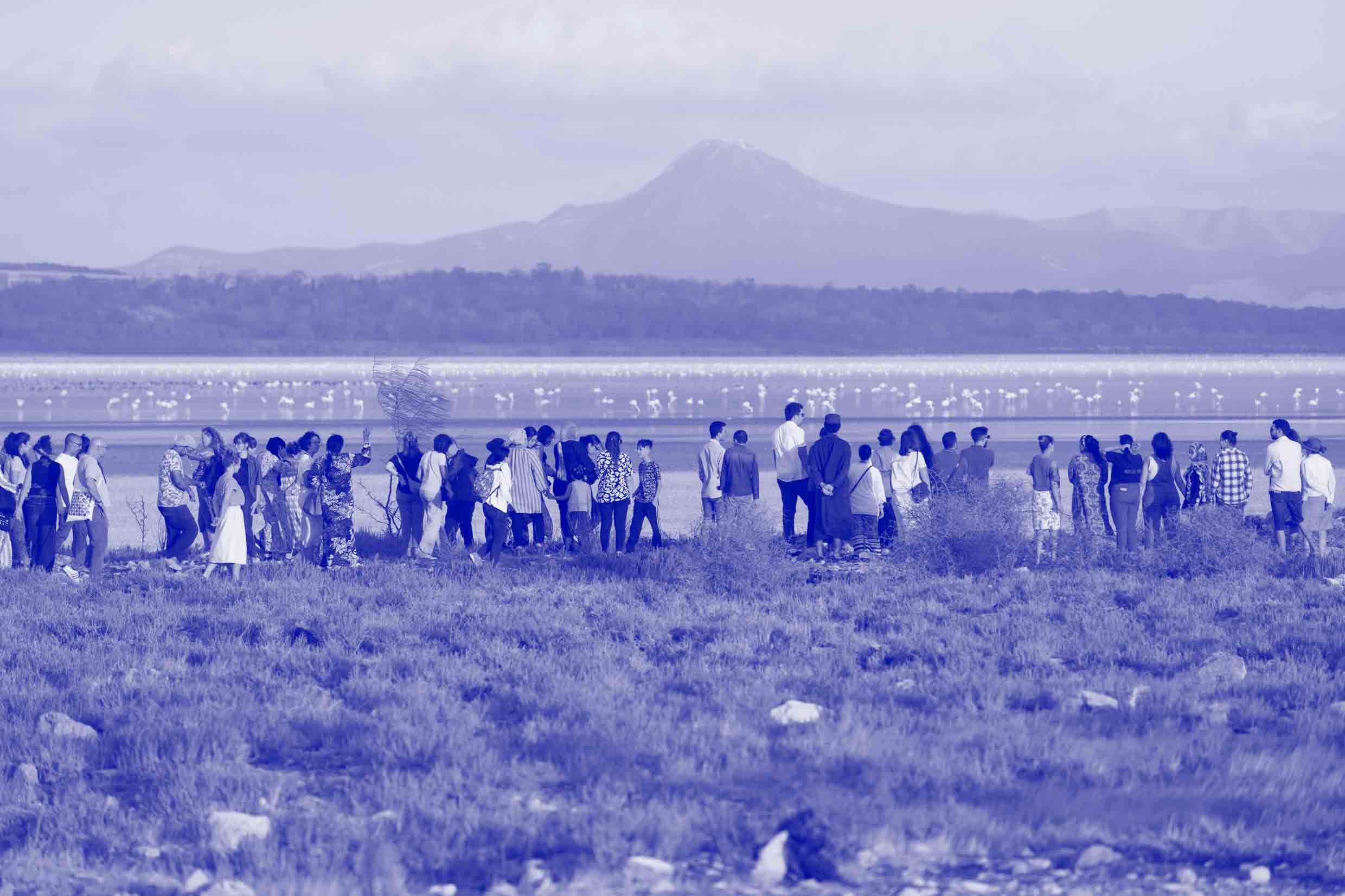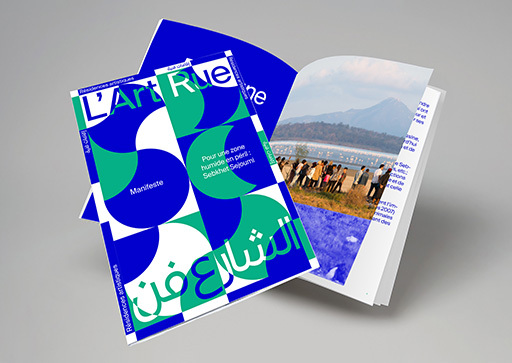A dialogue with Sebkhet Sejoumi by Natural Contract Lab
Maria Lucia Cruz Correia & Margarida Mendes
[Original text]
We commissioned this text for this edition of ZAT to describe the methodological framework behind the artistic practice of the collective Natural Contract Lab, whose work A Pact with waters – Communing with Sejoumi was a new creation for Dream City 2023.
 "Communing with Sejoumi" with Natural Contract Lab, Dream City 2023, photo by Pol Guillard
"Communing with Sejoumi" with Natural Contract Lab, Dream City 2023, photo by Pol Guillard
 "Communing with Sejoumi" with Natural Contract Lab, Dream City 2023, photo by Pol Guillard
"Communing with Sejoumi" with Natural Contract Lab, Dream City 2023, photo by Pol GuillardCollective Mourning: The Politics of Feeling
Have you ever felt sorrow due to the disappearance of a landscape that is close to you? A lake that has dried up or become increasingly polluted, or a forest set ablaze, will never be the same. The first time we walked by Sebkhet Sejoumi, a salt lake in Tunis, we shared a deep sense of loss, reminiscence and nostalgia for what used to be.
Through the practice of the Natural Contract Lab (NCL), we seek to activate artistic processes that enable the mourning of environmental loss while catalyzing the refusal or denial of ecological grief through the acknowledgment of personal and collective loss. Stewart Brand says, “Don’t mourn, organize”, a statement of refusal that prolongs the suppression of environmental grief as a largely unspoken and unrecognized emotional state. In NCL, we often find that there is a lack of public space for holding processes of environmental mourning, in part because it is not seen as an urgency in political agendas. When we work on a site and prepare it to host a collective mourning circle, we open a space that allows those who live in that environment to reframe their memories of loss, transforming our relationship into a shared concern. The act of remembrance becomes a political act, as does the freedom to express what has been lost. It is important to feel safe in these moments of collective sharing and to support each other in regenerating our militant battles to protect sacred waters.
"Hmm, it was our cherished football field – the place where we'd grab the ball, and sprint towards Sejoumi Lake. Those summer days were magical; the field felt inviting, with no fear of stumbling. We trusted the ground beneath us; it was right by our neighborhood, just behind us. We'd toss our t-shirts aside and dive into the game. Now, as I've grown up, driving by in my car, I see what was once an open land. The lake seems distant, separated by barriers of dirt. Even in the warmth of the summer, the once dry water is a poignant reminder of change."
- Nabil Aissaoui
In Sebkhet Sejoumi, the NCL engages in ongoing co-creation and artistic interventions aimed at fostering an active and sustained dialogue with bodies of water undergoing profound ecological change. The practice was presented at the Dream City Festival of 2023. During the NCL artistic residency in Tunis, founding artist Maria Lucia Cruz Correia, sound explorer and researcher Margarida Mendes, and nature jurist Marine Calmet facilitated several mourning circles at Sebkhet Sejoumi. These circles included groups of teenagers, activists, Sejoumi guardians, and female potters, with the goal of provoking thoughtful questions while appealing to sensory memories and personal stories. This approach allowed participants to re-imagine and envision possible interventions of reciprocal care towards the lake.
Resilience, Care, and the Rise of New Memories
The landscape of Sebkhet Sejoumi has changed drastically in recent decades. Once characterized by vast agricultural fields and sparse urban areas, it now faces challenges of urban expansion and embankments, resulting in the shrinking of its water body. Furthermore, the wetland is heavily polluted by runoff and domestic and industrial wastewater from a watershed that is affected by urbanization and the disorderly establishment of polluting industries.
When we walk in Sejoumi Lake, we step into the salicornia field and acknowledge its presence as a succulent being that reduces pollution and increases water flow. We listen to the voices of Sejoumi’s guardians, who, like resilient plants, face changing weather and the hardship of political conditions, while staying united, never give up dreaming of possible futures for Sejoumi. The disappearance of habitats is often seen as irreparable damage for which no one is held accountable. Weaving together the principles of restorative justice, we seek a new way of common living that recognizes water as an essential element of our lives. We seek reconciliation between victims and perpetrators — but in the case of ecocide, with NCL, we humbly try to acknowledge that we are entangled in complex diffuse relationships that make us both perpetrators and victims. Only when we're able to reconcile our relationship with the sacredness of the waters that live around us can we reconcile our relationship with the living.
As part of our process, we activate sensory exercises to raise awareness, creating context-specific gatherings, and water mourning circles where we open a space to share stories, memories of water, and personal narratives of solidarity towards other bodies of water that people have lost. We also share love letters to the waters, fabulations of what Sejoumi superheroes would be, and tools that project new forms of governance and care that would allow one to become a future Sejoumi guardian. These creative exchanges make it possible to live in a contested world, as one seeks shelter in the imagination, and the shimmering power of doing so collectively allows for new memories to arise together.
Eco-Scenography as a Ritual for Sebkhet Sejoumi
Walking and contemplating the Sebkhet Sejoumi, one can listen to the waste flying with the wind and nesting in the trees, while observing pink flamingos eating fish contaminated with microplastics. Inspired by the intricacy of ecological relationships, eco-scenography is concerned with interrelationships – between water and humans and other-than-humans – but also with the light, sounds, mud, and the materiality of ecosystems. Thinking with wetlands as spaces of intervention means integrating an awareness that the artistic choices concerning dramaturgy, script writing, rituals, and gatherings are intertwined with people and the surrounding ecosystem.
We incorporated principles of ecology to create upcycling, circular, and restorative actions with the Sejoumi, acknowledging that materiality and environments are interdependent. In the 2023 edition of the Dream City Festival, we collaborated with Aziz Romdhani, Nabil Aissaoui and other community members to design an eco-scenography for Agora Performance, which involved re-evaluating traditional construction techniques. This led to the adoption of a method of brick-building, that revolves around compressing mud from the area to create soil bricks. These bricks were used in the three-day performance and carried to different sites around the lake in a circular approach, endorsing how NCL uses an eco-scenography that activates spatial elements which dissolve over time to be re-integrated into the landscape. We opted to leave small traces of our gatherings rather than waste, as we wanted to start a dialogue with our surroundings and germinate new relationships and connections with the Sejoumi ecosystem and its inhabitants.
The first location of the performance was in the forest of Ibn Sina, where we held a space for listening, mobilizing, and dreaming with the voices of the people and guardians of the Sejoumi. After the event, we left a circle of soil-made benches in the forest as a lasting memory of the gathering. These benches may still be used by lake visitors who wish to rest and gather and have been activated several times over the months.
For the second location of the performance, we carried seven of these bricks to an olive grove by the lake, which is an example of farmers' resistance to local government policies. There, we held discussions on grief and forms of collective care with a small group of local activists. Encircling this space with bricks to hold the energetic circle of healing became a gesture of solidarity, while we attempted to create an alliance of rhizomatic care.
On the third day of the performance, we moved to the lake marshes, where pink flamingos bathe in the water next to the bird observatory of the association “Les Amis des Oiseaux”. At the home of the pink flamingos, we invited the Sejoumi Alliance* to join us in commemorating the changing ecosystems. Here, they walked in procession with all the soil bricks, setting an intention to rebuild the local bird observatory that was been destroyed in 2023. On that evening, we performed a celebratory ritual of collective building, expressing our wishes for the protection and restoration of Sejoumi in an evening accompanied by food and chants of resilience.
What collective practices do we need to design in order to have more reciprocate relationships of care towards bodies of water?
For the past four years, Natural Contract Lab has been walking-with, floating, and becoming the waters we collaborate with. Together, we research and learn from the water and its people, weaving our transdisciplinary practice to imagine an active and sustained dialogue with bodies of water undergoing deep ecological transformation. Our artistic interventions are hybrid, unfolding differently across each body of water as a dialogue and gesture of care with and through connected communities. To imagine new forms of justice, we have co-created an artistic Protocol of Reciprocal Care that combines practices of restorative justice, rights of nature, environmental grief, eco-scenography, and sensory scores. NCL is a collective body of care that invites others into moments of walking-with the river, mourning water circles, Agoras, Guardians of the River Schools, and other actions that emerge in collaboration with the fish, people, plants, and many other watery beings.
1 The Alliance that we have been collaborating with, includes Cyrine Ghrissi, Imen Labidi (RET), Radhia Louhichi (RET), Nabila Khlifi (teacher), Nabil Aissaoui, Claudia Feltrup-Azafzaf (AAO), Hichem Azafzaf (AAO), Dorsaf Yaakoubi, the women of Hay Hlel and group of people from the Dream City Festival.
Share
Read more
-
Letter from Sebkhet SejoumiCyrine Ghrissi
-
 Manifesto "For a wetland at risk: Sebkhet Séjoumi"
Manifesto "For a wetland at risk: Sebkhet Séjoumi" -
Visual Notes of a Fieldwork Research / Cluster of MatterBochra Taboubi
-
Haj Kanaan Shaina: A Voice from Ein QinyaTareq Khalef & Haifa Zalatimo
-
Where Nature Ends and Settlements BeginJumana Manna
-
Becoming Stateless, Overnight!Iyad Alasttal

